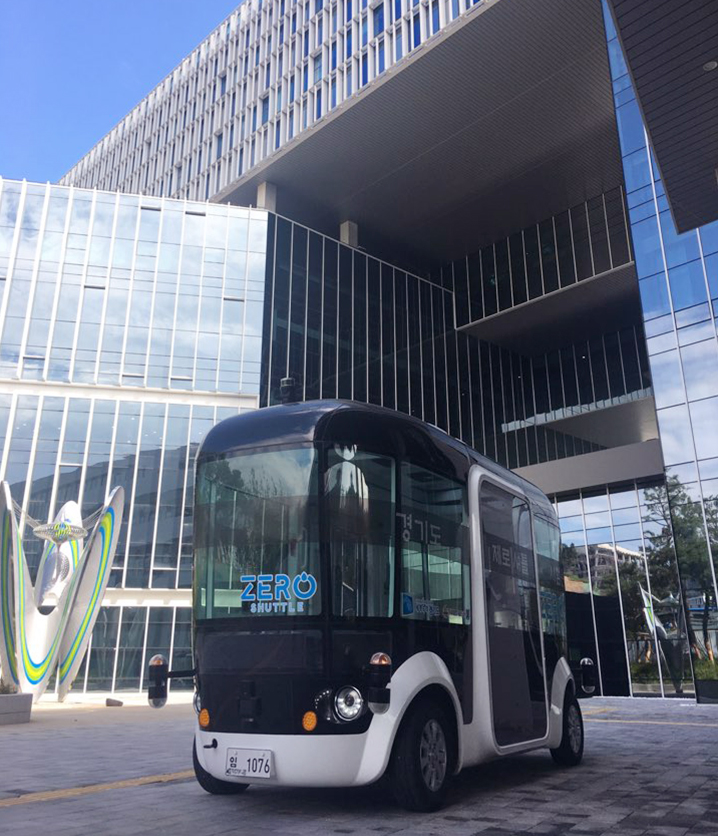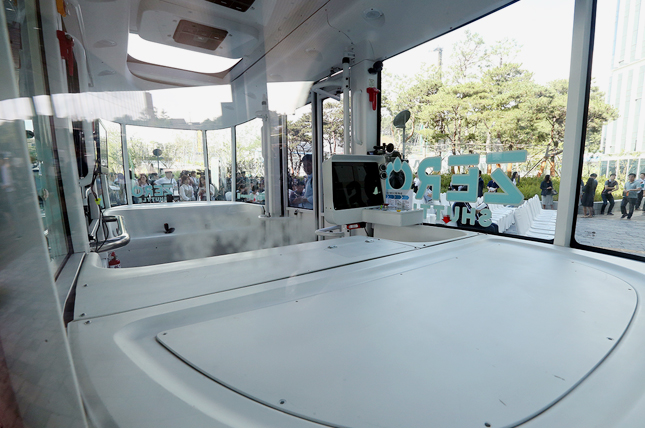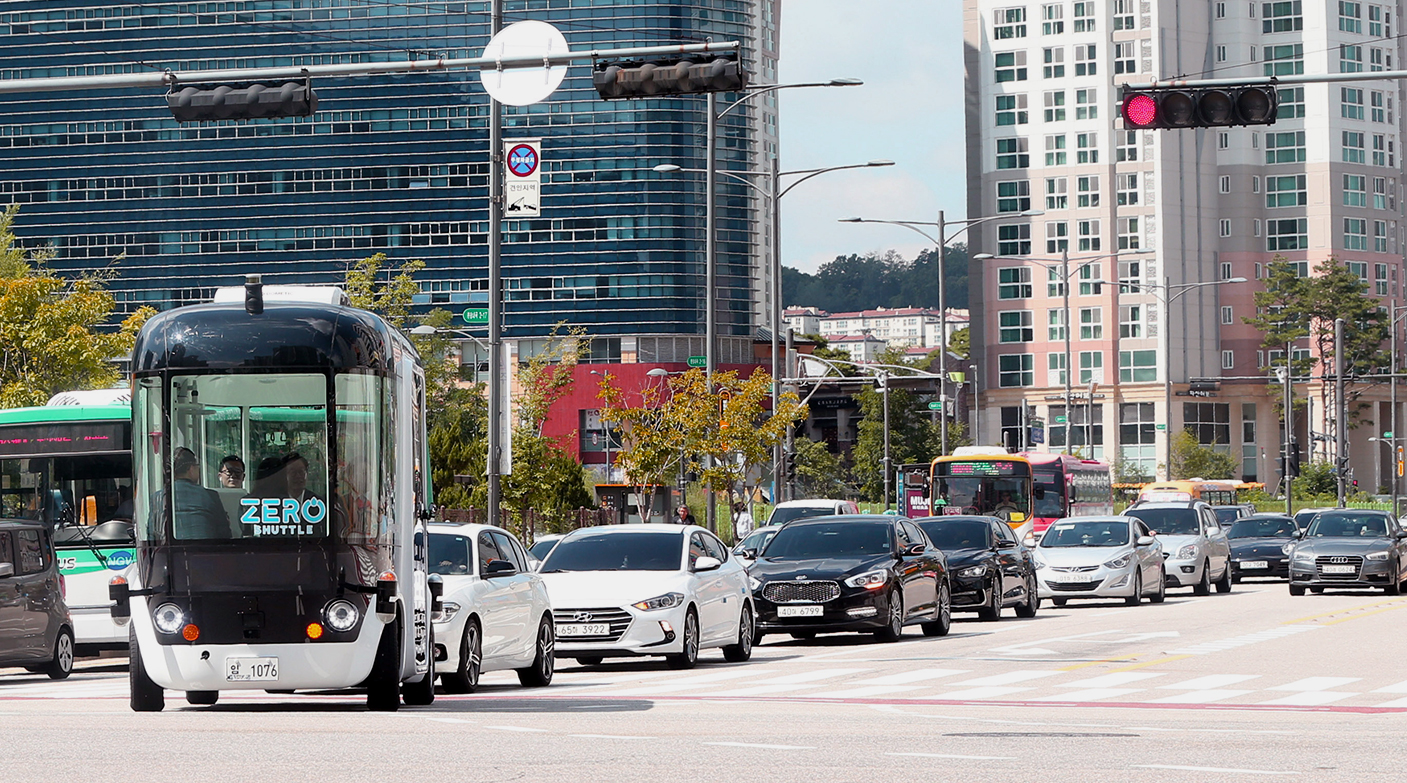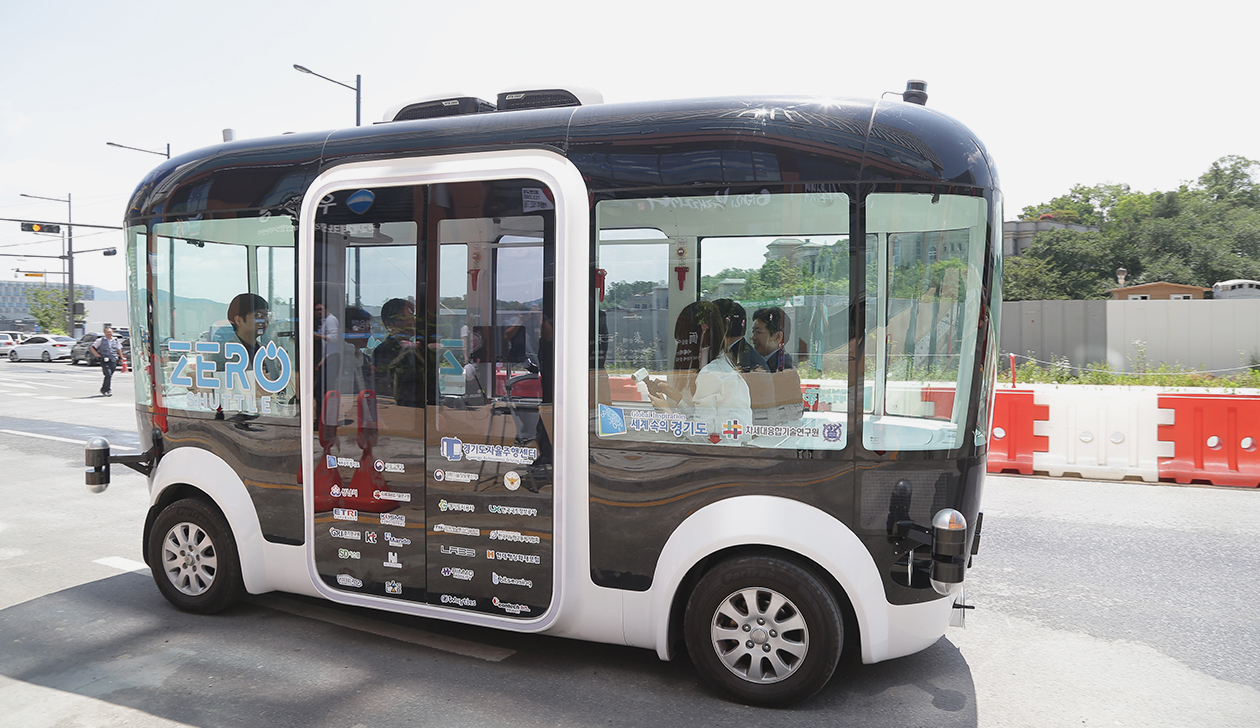VOL.55
August 2019


Trip — Pangyo Zero City
Zero Shuttle for
Future in City where
Imagination Becomes
Reality
Pangyo Zero City
On May 31, at the opening ceremony of the Gyeonggi Autonomous Driving Center organized by the Advanced Institute of Convergence Technology and the Gyeonggi Urban Innovation Corporation, the Zero Shuttle, which uses V2X (Vehicle to Everything) technology for self-driving shuttle service and control experience was unveiled. This imaginary futuristic car has now become a reality. The first step into that reality begins in Pangyo Zero City.


Inside of Zero Shuttle for up to 11 passengers
City that builds smart mobility
Pangyo Zero City is a testbed where self-driving cars are tested and demonstrated and a new city is being built using smart mobility services. Gyeonggi Autonomous Driving Center was established to operate Pangyo Zero City (Pangyo self-driving demonstration complex) and support self-driving demonstration research. The Center is also responsible for managing and operating IoT facilities and V2X infrastructure within Pangyo Zero City, lending V2X devices for testing by institutions and companies that want to demonstrate autonomous driving, and providing control monitoring, big data, and cloud services.
“Based on the real field experience for R&D, Pangyo Zero City was designed to offer infrastructure for self-driving tests and research spaces for indoor remodeling and studying self-driving cars,” said Director Jae-hwan Kim of Gyeonggi Autonomous Driving Center. For such services, Gyeonggi Autonomous Driving Center has built and operates Integrated Self-driving Control Center, Self-driving Data Center, Self-driving Business Center, and Self-driving Regulatory Sandbox.
The event on May 31 included a trial ride on Zero Shuttle, the self-driving car of Gyeonggi-do, and a 5G bus of KT. Produced by the Advanced Institute of Convergence Technology at the request of Gyeonggi-do, the Zero Shuttle carries up to 11 passengers as a self-driving electric shuttle. On that day, Zero Shuttle took a 5.8km course from the Gyeonggi Business Support Center via Pangyo Station and returned to the starting point. Also tested was KT’s 5G bus, which offers various contents including 106 multimedia broadcasting channels, games, and giga-speed live television based on the 5G network.

Zero Shuttle running along a 3km route between Gyeonggi Business Support Center and Avenue France Pangyo Station
Zero Shuttle emerging as a new means of transportation
Zero Shuttle is emerging as a new alternative to address serious traffic jams in Pangyo. The Advanced Institute of Convergence Technology developed Zero Shuttle to test and verify the self-driving infrastructure and system to be built in Pangyo Zero City before many citizens actually use the new means of transportation. The Zero Shuttle was also demonstrated as a public platform to test and evaluate the technology and products of small startups that develop elementary technology and parts for autonomous driving and collect self-driving big data.
Basically, autonomous driving technology collects data of real-time positioning and object recognition from sensors installed in self-driving cars. It also determines the driving situation and controls the car’s movement on the basis of AI algorithms in 3D virtual space by integrating 3D HD maps.
In Zero City, a number of self-driving cars need to coexist. Therefore, the data collected from sensors in each self-driving car is used internally and transmitted in real time through V2X communication to Integrated Self-driving Control Center, which integrates the data sent by many self-driving cars and the data collected from IoT sensors installed in infrastructure. The spatial data platform within the Center combines the location-based data in the virtual space based on the 3D HD map to recognize objects through AI algorithms. Through this process, the Center is able to understand the driving situation and provides infrastructure-level data to multiple self-driving cars through V2X communication.
Media Façade
Media Facade is a combined term of “media” and “facade” which means the external wall of a building. It is an imaging method that projects various images on the external walls of a building.

Zero Shuttle emerging as a new alternative to address serious traffic jams in Pangyo
First step into a new future
Pangyo Zero City is a futuristic smart city where cars and the urban environment offer more convenient IT-based everyday services. The word “zero” in the name indicates the local government’s commitment to reduce regulations, lower the risk of accidents, find missing children, stop environmental pollution, and reduce carbon emissions.
As the phrase “A good start is half the battle” suggests, the futuristic city that only existed in our imagination is now becoming a reality. Home-care AI analyzes your tastes and plays your favorite songs in the morning, and your AI oven prepares a nutritious breakfast. The biometric sensor attached to your pajamas checks your health condition and issues alerts through your AI assistant. The AI assistant also checks your scheduler and tells the destination to your self-driving car, which will find the fastest route and drive for you.
All of these will soon happen in the years to come. Everything will be connected to everything else and every system will share data. Maybe what we imagine and dream of is a fraction of what will really happen. What will the world look like with budding autonomous driving? Zero City may offer the self-driving experience that many of use imagined when we were young. The website for the Zero Shuttle opens in early July, and anyone can book a ride online.
Information
- Gyeonggi Autonomous Driving Center
- (Advanced Institute of Convergence Technology)
- #929, Gyeonggi Business Support Center, 42 Changeop-ro, Sujeong-gu, Seongnam, Gyeonggi
- 82-31-759-9043



